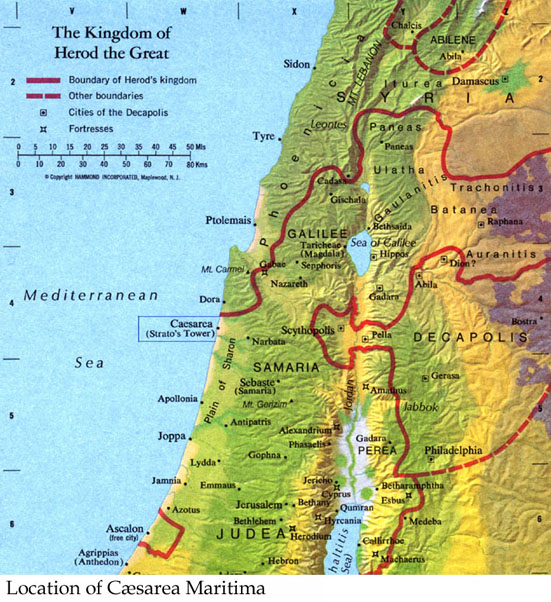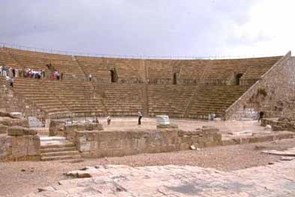Caesarea Maritima Thinking it is a Roman city, right? What gave it away? Yes, Caesarea is a city that Herod the Great dedicated to Caesar Augustus more than 2,000 years ago. Today, it is one of Israel’s major tourist attractions and an increasingly popular place for Israel’s elite to make their homes.  History Caesarea was originally called Straton’s Tower after its founder Straton, who is believed to have been a ruler of Sidon in the 4th century BCE. In 96 BCE the city was captured by Alexander Yannai and remained in the Hasmonean kingdom until it became an autonomous city by Pompey. After being for some time in the possession of Cleopatra, ruler of Egypt, it was returned by Augustus to Herod. Once the site of a Phoenician port, over the course of 12 years Herod built Caesarea into the grandest city other than Jerusalem in Palestine, with a deep-sea harbor (called Sebastos, i.e., Augustus in Greek), aqueduct, hippodrome and magnificent amphitheater that remain standing today. Herod renamed the city Caesarea in honor of the emperor. The population of Caesarea was half Gentile and half Jewish, often causing disputes among the people. In 6 CE, Caesarea became the home of the Roman governors (Procurators) of Judea. The city remained the capital of Roman and Byzantine Palestine. The Great Revolt of 66-70 CE started in Caesarea when the Jewish and Syrian communities began fighting over a pagan ceremony conducted on Shabbat near the entrance of a synagogue. The Romans ignored the Jewish protests of this provocation and violence soon spread throughout the country. When the Romans finally quelled the revolt, and razed Jerusalem, Caesarea became the capital of Palestine, a status it maintained until the Roman Empire was Christianized by the Emperor Constantine in 325 CE. Caesarea was also the site where the Romans tortured and executed Rabbi Akiva following the Bar Kochba revolt in 135 CE. Caesarea is an important site in Christian history. It was the place where Pontius Pilate governed during the time of Jesus. This was where Simon Peter converted the Roman, Cornelius, the first non-Jew to believe in Jesus. Paul was also imprisoned for two years in Caesarea. During the 3rd century, Caesarea was a center of Christian learning. In the 4th century, the site converted to Christianity and became a major center of the Christian Roman Empire. In 640 CE, Caesarea was the last Palestinian city to fall to the Muslim invaders. After the Muslims swept out of Arabia and across the Middle East, driving out the Romans, Palestine was largely neglected. In 1101, the Crusaders captured the city under the leadership of Baldwin I, only to lose it in 1187 to Saladin. Under the Crusader rule, the Jewish community of Caesarea dwindled until in 1170 only 20 Jews remained. From 1251-1252, the city was entirely reconstructed by Louis IX. In 1265, Caesarea fell to Baybars, the Mamluk sultan of Egypt, who destroyed the city, which remained in ruins until 1884. In 1884, a small fishing village was established on the remains at Caesarea by Muslim refugees from Bosnia. The city was abandoned by its inhabitants during the War of Independence (1948). Relics  Today, the amphitheater is not only a spectacular relic of the past, but a modern performing venue where concerts are frequently held. Inside the gate of the theater is a plaque with a replica (the original is in the Israel Museum in Jerusalem) of the inscription found during excavations in 1959-63 with the words “TIBERIVM” and “TIVS PILATUS,” references to Emperor Tiberius and Pontius Pilate, the governor of Judea at the time of Jesus. This was an important find because it is the only archaeological evidence of Pilate’s existence. Undoubtedly, you’ll be informed that the entrances to the theater are known as vomitoria. The name does not come from the reaction of patrons to a show but is simply a word meaning vaulted passageway. The inside of the theater is not only impressive as a remnant of the glory days of Rome, but for its spectacular view of the Mediterranean. In 21 BCE, Herod the Great built a massive, two-part harbor, an inner and outer harbor, at Caesarea. The all-weather harbor was constructed by using hydraulic concrete to create breakwaters in the sea. The harbor took twelve years to construct. Herod named the harbor Sebastos, in honor of Emperor Augustus. The Roman historian Flavius Josephus describes the harbor; “the king triumphed over nature and constructed a harbor larger than the Piraeus, including other deep roadsteads within its recesses. Notwithstanding the totally recalcitrant nature of the site, he grappled with the difficulties so successfully, that the solidity of his masonry defied the sea, while its beauty was such as if no obstacle had existed.” Archeological evidence suggests that the outer harbor had serious structural problems by the end of the 1st century CE. Today the Herodian breakwaters are submerged 5m below the water surface. The hippodrome built by Herod also is still identifiable, though it is now a banana field. Considerably smaller than the great Circus Maximus in Rome, Herod’s arena still held 20,000 spectators for chariot races. The later rulers also left behind interesting artifacts two huge white marble statues, both headless. They probably were originally made to honor two Roman emperors, but no one knows which ones. It is also a mystery as to how the statues lost their heads. They could have been lopped off by Christians, Muslims or Jews angered by the way they were treated by the Romans or offended by such idols. Vestiges of the fortress walls built by the Crusaders are monuments to yet another fascinating period in Israel’s history. One of the legendary acts of particular interest to Christians involves the Holy Grail, the goblet that was said to have been used by Jesus at the Last Supper. The Grail was supposedly taken to Genoa as booty by the Genoese invaders who helped the Crusaders conquer the city in 1101. The Crusader fortifications were embellished by King Louis IX of France — St. Louis — who spent a year in Caesarea after being released from prison in Egypt in 1251. He helped build the city walls with his own hands. In 1265, the Mamluks drove out the Crusaders and the Sultan tore down the walls, reputedly saying, “What a king has built, a king will destroy.” Other archaeological finds from Caesarea can be seen in the museum at nearby Kibbutz Sdot Yam. In addition to exhibits of antiquities, the kibbutz is also the home of the Hannah Senesh House, a museum depicting the heroic story of the young woman who volunteered for the British army and parachuted behind enemy lines during World War II. Senesh (also Szenes) was captured and tortured but would not betray her comrades. She was executed by the Germans in 1944. |